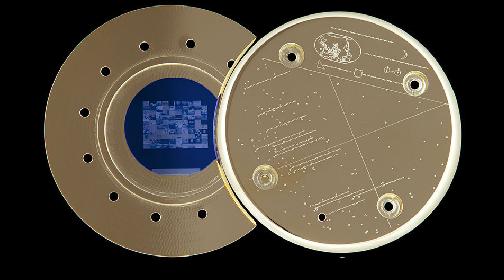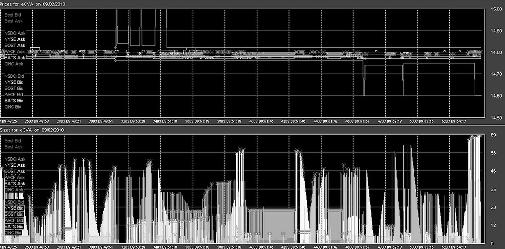Computerworld - The problem: You want to send images into space and you want them to last 5 billion years. The solution: A gold-plated disc.
That's the idea behind The Last Pictures project, which is scheduled to blast off in the next few months.
The project involves attaching a silicon disc encased in gold to the outside of a communications satellite. The disc will include just 100 etched photos, which are meant to be a cultural artifact for aliens to find if mankind is no longer here when they come knocking.
The disc, designed by researchers at MIT and Carleton College, is filled with images chosen by artist Trevor Paglen and a team he put together, who are working with the nonprofit arts organization Creative Time and the media and satellite company EchoStar.
The golden artifact is hitching a ride on the EchoStar XVI satellite, which once in orbit will be fully leased to DISH Direct-to-Home services in the United States. After several technical problems, the satellite is now scheduled to blast off in the November-December timeframe from the Baikonur Cosmodrome, the world's first and largest space launch facility located in Kazakhstan.
Since the conclusion of the U.S. Space Shuttle program, Baikonur has become the sole launch facility for manned missions to the International Space Station.

The black and white pictures that Paglen chose were also recently published in a book. They include photos of a meteorite, a dust storm hitting an American Midwest neighborhood, a ship traversing a canal and cherry blossoms.
Looking at the photographs, a theme is somewhat inscrutable -- an observation that Paglen himself admits. For example, a photo of a group of people taken by a predator drone joins several photos of 17,000-year-old cave paintings.
One of the more impalpable photos is of "financial crop circles," or trading activity patterns created by automated high-speed computer algorithms. One photo shows Native American petroglyphs from Canyon de Chelly in Arizona.

"What it depicts is Spanish raiders arriving in the Navajo territory. So really, it's an image of an alien invasion," he said. "So that was a powerful image for us in thinking about the history of empire and war and how the West and in fact much of the world [and civilization was developed]."
While at first blush the photos can seem to have been chosen at random, Paglen carefully picked the zeitgeist over a period of five years. The process included a group of artists from Creative Times, which commissioned the project.
The six artists spent eight months collecting images, everything from medieval alchemical texts to the history of cameras and messages in bottles to cybernetics (the study of mechanical, physical, biological, and cognitive systems).
Paglen also performed extensive interviews with other artists, philosophers, and scientists, who included biologists, physicists, and astronomers. To each, he posed a single question: What photos would you choose to send into outer space?
The scientists from MIT also offered the artist a fresh philosophical perspective with regard to understanding what the images may mean to aliens a billion years from now.
"Cave paintings became the obvious reference," Paglen said. "They tell us about the prehistoric environments of the ecology and perhaps even of the lifestyles of long ago that we know very little about."
19,000 miles above Earth
Once launched, EchoStar XVI will function for about 15 years and then go dead, orbiting 19,000 miles above Earth for five billion years. Why five billion? That's when scientists estimate the Sun will run out of hydrogen, become a red giant and expand, consuming the planets around it.
Until then, if humans do follow the dinosaurs and become extinct, there will be plenty of evidence of our existence left behind. Over the past 50 years, more than 800 spacecraft have been launched into geosynchronous orbit.
After a relatively short life, hundreds have become nothing more than floating junk. The debris have formed a ring of technology -- artifacts in there own right -- around Earth.
"These satellites are destined to become one of the longest-lasting artifacts of human civilization, quietly floating through space long after every trace of humanity has disappeared from the planet," Creative Time states in its online introduction to the project.
It's not the first time that artifacts have been launched into the heavens in the hope that they will someday be discovered by alien civilizations.
In 1977, NASA launched the Voyager spacecraft with a gold-plated photographic-style record on board. The record contained both sounds and etched images that portrayed the diversity of life and culture on Earth.
Voyager was sent past several planets, including Pluto in 1990 and left our solar system in November 2004. The spacecraft wasn't pointed at any particular star, but the golden platter was placed onboard with the hope that distant civilization might stumble upon it.
Voyager and its golden record has since become the thing of movie legend, having appeared in both Star Trek: The Motion Picture in 1979 and Starman in 1984.
But the Voyager's record, made of copper, will deteriorate relatively quickly, as the atoms in metal tend to clump together over time and liquefy. So, creating a modern an artifact that would last billions of years posed a theoretical problem for scientists.
"The scientists at MIT felt we needed something that had a crystalline structure rather than atomic," Paglen said. "So they chose silicon."
MIT used a machine to etch the photos into the silicon using a bitmap format to create a binary image.
Once the images were etched, one question remained for everyone involved in the project. What impression might aliens get from the artifact?
"I think one part of me thinks it will mean nothing at all to them. That part of me understands the way we see images now is very culturally specific," Paglen said. "But I also worked with scientists at MIT and those guys thought these images would be found by robots, and those robots would understand what they meant."





